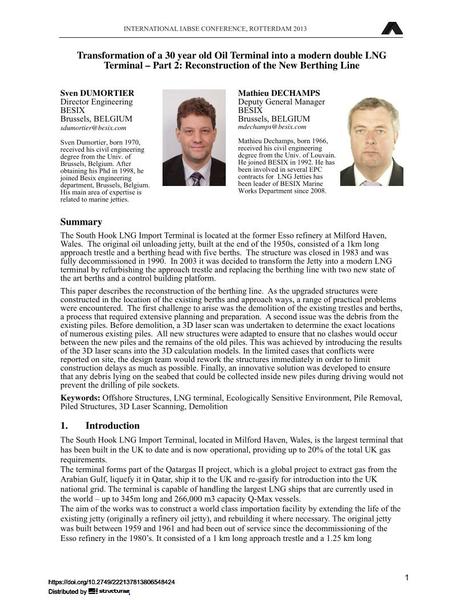Transformation of a 30 year old Oil Terminal into a modern double LNG Terminal – Part 2: Reconstruction of the New Berthing Line

|
|
|||||||||||
Détails bibliographiques
| Auteur(s): |
Sven Dumortier
Mathieu Dechamps |
||||
|---|---|---|---|---|---|
| Médium: | papier de conférence | ||||
| Langue(s): | anglais | ||||
| Conférence: | IABSE Conference: Assessment, Upgrading and Refurbishment of Infrastructures, Rotterdam, The Netherlands, 6-8 May 2013 | ||||
| Publié dans: | IABSE Conference, Rotterdam, May 2013 | ||||
|
|||||
| Page(s): | 564-565 | ||||
| Nombre total de pages (du PDF): | 8 | ||||
| Année: | 2013 | ||||
| DOI: | 10.2749/222137813806548424 | ||||
| Abstrait: |
The South Hook LNG Import Terminal is located at the former Esso refinery at Milford Haven, Wales. The original oil unloading jetty, built at the end of the 1950s, consisted of a 1km long approach trestle and a berthing head with five berths. The structure was closed in 1983 and was fully decommissioned in 1990. In 2003 it was decided to transform the Jetty into a modern LNG terminal by refurbishing the approach trestle and replacing the berthing line with two new state of the art berths and a control building platform. This paper describes the reconstruction of the berthing line. As the upgraded structures were constructed in the location of the existing berths and approach ways, a range of practical problems were encountered. The first challenge to arise was the demolition of the existing trestles and berths, a process that required extensive planning and preparation. A second issue was the debris from the existing piles. Before demolition, a 3D laser scan was undertaken to determine the exact locations of numerous existing piles. All new structures were adapted to ensure that no clashes would occur between the new piles and the remains of the old piles. This was achieved by introducing the results of the 3D laser scans into the 3D calculation models. In the limited cases that conflicts were reported on site, the design team would rework the structures immediately in order to limit construction delays as much as possible. Finally, an innovative solution was developed to ensure that any debris lying on the seabed that could be collected inside new piles during driving would not prevent the drilling of pile sockets. |
||||
